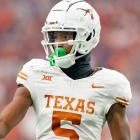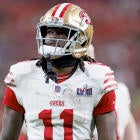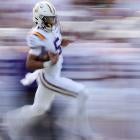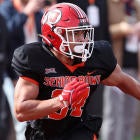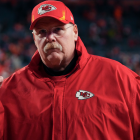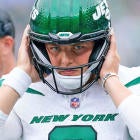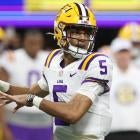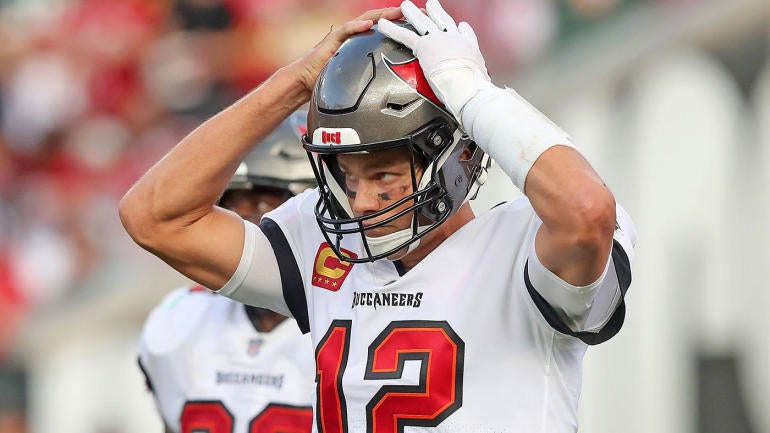
Through three weeks, the Tampa Bay Buccaneers are in an offensive funk. Sure, they have played against three strong defenses in the Dallas Cowboys, New Orleans Saints, and Green Bay Packers. But strength of opponent does not fully explain the Bucs ranking 27th in yards, 22nd in points, and 20th in drive success rate despite the seventh-best average starting field position in football. It doesn't explain Tampa checking in 28th in yards per play, 31st in points per drive, and 31st in EPA per play.
The biggest factor in that under-performance so far is undoubtedly injuries and other player absences.
Tampa's two starting guards from last season -- Ali Marpet and Alex Cappa -- are no longer with the team after Marpet retired and Cappa left in free agency. One of the two replacements -- Shaq Mason, acquired in a trade from the Patriots -- has been on the field for every snap this season. But the other -- Aaron Stinnie -- tore his ACL during training camp and has been replaced in the lineup by rookie Luke Goedeke. Stalwart center Ryan Jensen suffered a serious knee injury of his own, and has been replaced in the lineup by 2021 third-round pick Robert Hainsey. Left tackle Donovan Smith left Week 1 with an elbow injury and has not played since. His replacement, Josh Wells, suffered an injury as well.
So, a year after Smith, Marpet, Jensen, Cappa, and Tristan Wirfs played 94.9% of all available snaps along the offensive line, Tampa's preferred starters (Smith, Stinnie, Jensen, Mason, and Wirfs) have played just 42.3% of the snaps. Amazingly, all the offensive line shuffling has not yet resulted in a dramatic increase in the amount of pressure on Tom Brady -- largely because Brady is somehow getting the ball out of his hands even faster than he was a year ago. His average throw has come 2.27 seconds after the snap, according to Tru Media, the fastest mark in the league, and 0.11 seconds faster than his second-ranked time from last season. (For context, the league average is 2.71 seconds.) That's how Brady's pressure rate is almost exactly equal to his mark from last year. What's changed, though, is that when defenses have manage to get pressure, they have gotten Brady to the ground far more often.
| Year | Pressure % | Sack % | Sack/Pressure |
|---|---|---|---|
| 2021 | 20.0% | 3.0% | 14.7% |
| 2022 | 19.3% | 5.5% | 28.6% |
Surely, some of that is due to the injury issues at wide receiver, and the resulting trouble the remaining players are having getting open. Last season, Mike Evans and Chris Godwin accounted for 55% of all possible wide receiver snaps. With Godwin having gotten injured during Week 1 and Evans getting suspended during Week 2, that duo has accounted for just 21% of the snaps given to wide receivers this year. With Julio Jones also missing the past two games due to injury and Russell Gage playing through an injury of his own in the first two weeks, this offense has been far more reliant on the likes of Breshad Perriman and Scottie Miller than anybody imagined it would be. They even threw Cole Beasley out there last week after signing him just a few days earlier.
Despite all the turnover at the position, Brady is actually throwing to his wideouts more often (68.0% of his passes) than he did last season (55.5%), presumably because Rob Gronkowski has been lost to retirement and neither Cameron Brate nor Kyle Rudolph gets open quite as often, and some of the backfield snaps that used to go to Giovani Bernard are now all consumed by Leonard Fournette, who is touching the ball often enough as a runner and already seems a bit worn down by the load he is carrying for the offense.
Brady has also been uncharacteristically inaccurate, throwing off-target in 12.6% of his throws, a slightly-above-average mark. Perhaps that's a reaction to the increased sack rate. Perhaps it's unfamiliarity with the pass-catchers. Perhaps it's both. Perhaps he's just 45 years old and not going to be picture-perfect forever. Whatever is driving the level of performance, this is not supposed to be a passing offense that needs Brady to perform at a super-human level in order to function at a reasonable clip. Of course, it's better if he does do that, but the infrastructure is supposed to be good enough that he doesn't need to have his A-plus game every single week. Right now, it isn't.
The lack of success in the pass game has led Tampa to become a more run-focused offense, at least so far. The Buccaneers' pass-rate over expectation, according to Tru Media, has dropped from plus-3.4% to minus-4.8%. But even their running game has been largely unsuccessful, which is not all that surprising considering the myriad issues along the offensive line.
Fournette's carries have been stopped at or behind the line of scrimmage 21.1% of the time this season, for example, a significant rate spike from last year's 12.2% mark. It doesn't help that he is running into stacked boxes more often, with the Bucs seeing eight or more defenders in the box on 24.1% of non-red zone plays, compared with 17.6% of such plays last season.
But Fournette also isn't doing as good a job as an individual driver of rushing success. He's avoided a tackle on only 12.3% of his rush attempts this season, down from 23.3% last year; and as a result, he's averaging only 2.47 yards after contact per carry, whereas last year he was at 3.15 per carry. Offensive coordinator Byron Leftwich said this week that he wants to get rookie running back Rachaad White more involved in the offense, and that might be a good idea, if not just to spell Fournette, then maybe to get a bit more explosion in the run game.
Hopefully some of these issues can be alleviated by getting the proper personnel back in the fold. Evans will return from his suspension this week. Jones, Gage, and Smith have all practiced on a limited basis ahead of Sunday night's game against the Chiefs. Godwin got in a limited session on Wednesday but was a DNP on Thursday.
The lack of continuity and diminished talent up front is likely to remain, but nobody in history is better than Brady at identifying before the snap where to go with the ball, and then doing so as quickly as possible. He can mitigate at least some of the talent drop-off. Then, it's up to the receivers to get to work, both by creating more separation and by gaining more yards after the catch. Once the pass game gets going, the boxes will open up, and they can get back to Fournette doing better work on the ground. It might take some time, but the pieces are still there for this team to be quite successful. Despite that not being the case to date, they've managed to win two of their first three games anyway. More likely than not, they're going to be fine eventually.














